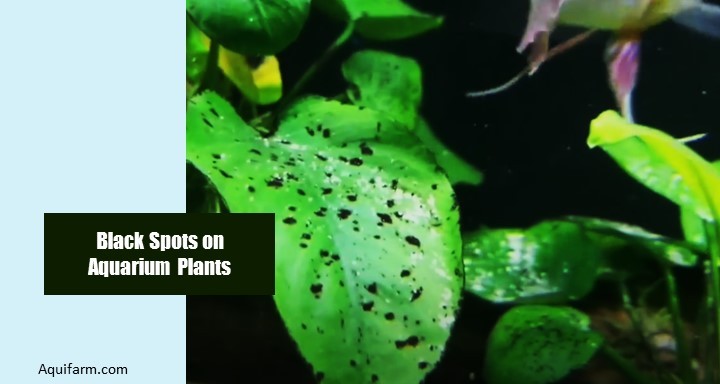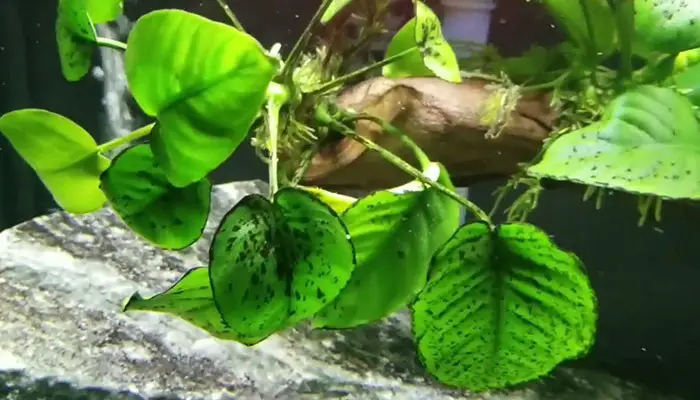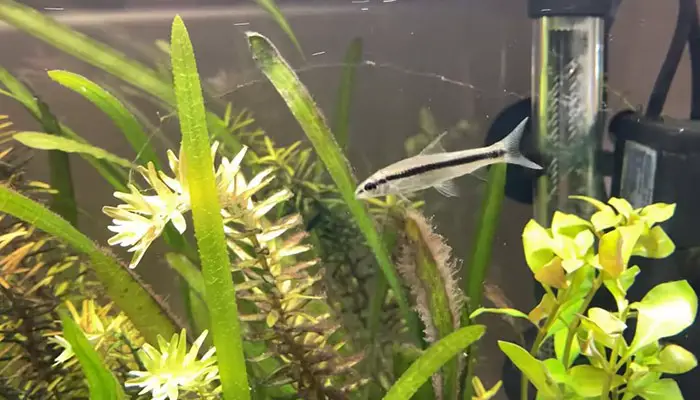
Different varieties of aquarium plants enhance the beauty of an aquarium. These plants stabilize the pH level of the fish tank water and prevent different bacteria and algae. Besides, they provide sufficient oxygen to the fish by photosynthesis.
However, you need to take care of the aquarium plants along with the aquatic animals. Otherwise, many serious problems can happen. The black spots on aquarium plant leaves are one of them.
Now, why do I see black spots on my aquarium plants? Typically, aquarium plants get black spots because of the black beard algae. In addition, other primary causes are- the high phosphate level, light, water quality, and lack of nutrients.
For this purpose, you have to figure out the main cause of black spots on plants in a fish tank and then deal with it accordingly. So, keep reading and you will find the causes behind these black spots and their solutions.
Why Are There Black Spots on My Aquarium Plants?

1. Black Beard Algae
One of the common causes behind this problem is the black beard algae. The black beard or black brush algae is a member of the red algae family.
The black algae is a common aquarium algae. Although most of the time it appears in black, it can also be dark green, olive green, or gray. Besides, it strongly clings to the plants, aquarium substrate, and decorations and is difficult to get rid of.
The black beard algae usually grow on aquarium plants for so many reasons. For instance, insufficient carbon dioxide helps to grow the black beard algae faster. Other reasons are- waste food, excessive light, poor water quality, and much more.
Although the black beard algae are not harmful to aquatic animals, they can kill any aquarium plant. When the black brush algae cover the whole plant leaves, they cannot continue the photosynthesis process. Thus they cannot produce food and die later.
2. Phosphate
The high phosphate level is always a big issue in the aquatic environment. It not only pollutes the whole aquarium but also harms the fish. So, the high phosphate level is another reason for black spots on the aquarium plants.
Typically, the phosphate level increases in the fish tank water because of low maintenance. In other words, if you don’t change or filter the aquarium water regularly, it becomes dirty over time. As a result, the phosphate and nitrate level increases in the water.
That’s why your aquarium plants turn black. What’s more, if you don’t take action in time, it will cause many harmful fungal and bacterial infections.
3. Light Imbalance
Too much or too low light is not good for the aquarium plants. There must be a proper light supply in the fish tank to keep the plants and animals healthy.
For example, if the fish tank gets excess light or direct sunlight, the black beard algae will grow easily on the plants and the whole aquarium. On the other hand, insufficient sunlight also causes black spots or black patches on the aquarium plants.
4. Water quality
If the fish tank water is not clean enough, it can produce many fungi and bacteria. As a result, the plants and other decorations are covered with black marks.
For example, if you don’t change the aquarium water from time to time, the nitrate and ammonia levels increase in the fish tank. As a result, black dots or marks are found on the aquarium plants. Besides, dirty water also helps to produce phosphate and black beard algae which cause black spots on the plants.
5. Improper Nutrition
You need to make sure that the aquarium plants get a proper amount of nutrition. Otherwise, the plants will become yellowish or blackish.
For instance, the high nitrate level in the aquarium does harm to the plants. It will leave black or dark brown spots on the plant leaves.
On the other hand, excessive iron is also not good for aquarium plants. Although the high iron level in the water makes the leaves yellow at the first stage, those affected leaves will eventually turn black before dying.
Now, nutrient deficiency in fish tank water may happen for many reasons. However irregular care of the aquarium is the main cause behind it.
How Can I Get Rid of The Black Spots on My Aquarium Plants?
Eliminating the black spots from the aquarium plants is crucial for the overall aquarium environment since it can be a sign of many contagious diseases. So, if you notice some black dots on aquarium plants, you should look for the reason first and then take action accordingly.
Keep reading to learn all the solutions according to the problems.
Vacuum Cleaning
Sometimes, the aquarium decorations and plants get black spots because of the dirty fish tank. So, vacuum cleaning is the best option for that. You can find many good gravel cleaners online. (Our Pick: hygger Aquarium Gravel Cleaner)
For this purpose, take a good gravel cleaner and firstly vacuum the aquarium substrate. Then, clean the fish tank glass and other decorations. Besides, you can also softly scrub the plant leaves with a brush if the leaves get black spots only for the dirt.
Water Filter
If the black spot problem happens because of poor water quality, then you must change the water or add a filter media to your fish tank.
But firstly, test the water to know the nitrate and phosphate levels. You can do this test with an aquarium water test kit. (Our Pick: API FRESHWATER MASTER TEST KIT)
If the phosphate level is high, you need to change the water. You can use DI (Deionized) or RO (Reverse Osmosis) water for a change instead of regular tap water. Later, add some aquarium salt to the fish tank (our pick: API AQUARIUM SALT Freshwater Aquarium Salt) After a few days, you will see that the black marks on the plants are gone.
Phosphate Absorbing Filter
If the water changing method seems troublesome for you, then add a phosphate absorbing filter to the aquarium. It will control the phosphate level in the fish tank. (Our Pick: Fluval ClearMax Phosphate Remover)
So, if you start doubting that the aquarium plants get black spots because of the high phosphate level, then test the water. After that, set a good phosphate absorbing filter media with your fish tank. This media will absorb the excess phosphate and the plants will get back to their original color over a few days.
Removing Black Beard Algae
The black beard algae cling to the aquarium plants so strongly that it is difficult to remove them. What’s more, if you don’t take immediate action, this algae will cover the plants and kill them. So, follow the instructions afterward to know how to get rid of black beard algae–
- Vacuum clean the aquarium substrate with a gravel cleaner to clean the excessive food and organic waste.
- If you see some black beard algae only on the edge of some leaves, then simply trim or cut the leaves.
- Lack of carbon dioxide causes the black beard algae. So, inject the carbon dioxide into the aquarium water to stabilize its level.
- If the aquarium plants and other decorations get covered with a heavy layer of black beard algae, then hydrogen peroxide is your only effective solution. It works best against black beard algae. So, soak the whole fish tank with 3% hydrogen peroxide solution. But, you must follow the manufacturer’s instructions.
- Slow down the water flow in the fish tank since heavy flow helps the black beard algae to grow faster.
How to Prevent Black Spots on Aquarium Plants?

Preventing the problem is always easier than solving it. That’s why we came up with some amazing ideas to help you prevent black spots on the aquarium plants.
Light Adjustment
A proper light adjustment is necessary for a fish tank. Insufficient light or too much sunlight is not good for the aquarium environment. For example, too much light is the main cause of growing black beard algae in the fish tank.
So, make sure that your aquarium doesn’t get light for more than 12 hours in a day. In addition, do not keep the fish tank near a window so that the fish tank cannot get direct sunlight.
It’s always a wise idea to use electric light. So, a 15W single tube will be enough for a 10 gallons fish tank.
BBA Eating Fish
Keeping a black beard algae (BBA) eating fish in the aquarium is one of the effective ways to prevent the black beard algae.
Siamese Algae eaters, Catfish, and Otocinclus are some of the fishes that love to eat black beard algae. So, once the black algae start to grow in the fish tank, they will eat away to get rid of it.
Sufficient Space
An overcrowded aquarium produces many harmful bacteria and fungi that spread different kinds of infections later. Besides, it is also the reason for growing the black beard algae and excessive phosphate.
More animals produce more organic waste and you need to change the water frequently. So, do not overstock the aquarium with fish and other aquatic animals. It will maintain a healthy environment.
Maintenance
Proper care of the fish tank is the most important matter to prevent black spots on the aquarium plants. In their words, if you want to see your aquatic pets and plants living a happy and healthy life, take good care of the aquarium environment.
Firstly, you need to change the aquarium water from time to time. Besides, you can use RO water instead of tap water. Moreover, you can also add good filter media to the aquarium since it ensures good water quality
On the other hand, you have to test the ammonia and phosphate levels, pH balance, and the temperature of the tank water. Besides, you can use the ammonia and phosphate absorbing filter media to maintain a proper balance.
More Plants
You can add some more plants to your fish tank. It’s because the live plants take excess nitrate as their fertilizer. That’s why the nitrate level cannot go high in the aquarium.
Moreover, more plants mean more competition for nutrients. As a result, the black beard algae cannot get enough nutrients for growth. So, your aquarium plants also get safe from the black spots.
Frequently Asked Questions
Are The Black Beard Algae Harmful To My Aquarium Plants?
Although the black beard algae do not cause any harm to the fish and other aquatic animals, it can be quite dangerous for the aquarium plants. It’s because when the black algae fully cover the plant leaves, the plants cannot continue the photosynthesis process and die eventually.
Why Are My Aquarium Plants Turning Black?
Your aquarium plants may turn black because of insufficient nutrients or excessive sunlight. For example, direct sunlight is good for the black beard algae and the plants turn black for this algae. On the other hand, polluted water is also a strong reason to turn the aquarium plants black.
What Causes High Phosphate Levels In The Fish Tank?
The high level of phosphate is one of the most common reasons for black spots on aquarium plants. Typically, the dead plants, waste food, and organic wastes are responsible for the high phosphate level in the aquarium water.
Conclusion
The aquarium plants are important to keep the aquatic animals and the entire aquarium environment healthy and clean. So, you must take proper care of the aquarium plants.
But, why are there black spots on my aquarium plants? Firstly, you need to figure out the causes behind the black mark on the plants. After that, you must take the necessary actions to get rid of it. Besides, some prevention methods will also help you get rid of black spots permanently.
This article has described all the necessary information regarding black spots on aquarium plants. So, we hope that you will find it handy.
- Top 15 Freshwater Aquarium Plant Ideas for a Lush, Green Tank - November 9, 2024
- Top 13 Freshwater Aquarium Layout Ideas for a Beautifully Organized Tank - November 9, 2024
- 14 Stunning Rustic Freshwater Aquarium Ideas for a Tranquil Environment - November 9, 2024
